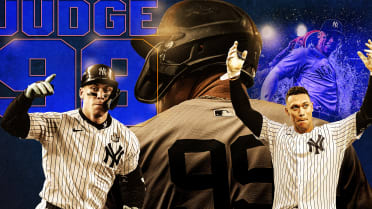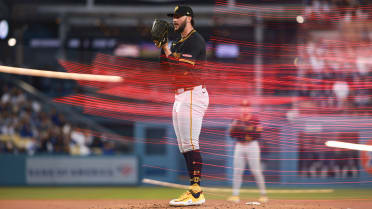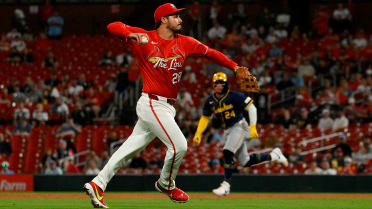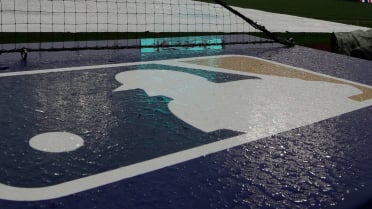The streak is over.
When the National League pulled out a dramatic 3-2 victory over the American League in the 2023 All-Star Game at Seattle’s T-Mobile Park on Tuesday night, it snapped the AL’s run of nine consecutive wins. That was the second-longest streak in All-Star Game history (which goes back to 1933), behind an 11-game burst by the NL from 1972-82.
The dominance went beyond that, too, with the AL holding a 27-6-1 record since 1988, after the NL started out 41-16-1. But now the NL has put its foot down with its first All-Star Game victory since 2012 at Kansas City’s Kauffman Stadium, an 8-0 blowout.
One bit of symmetry? The winning pitcher in 2012 was the Giants’ Matt Cain, and the winning pitcher on Tuesday was the Giants’ Camilo Doval, who tossed a scoreless seventh inning. Those are the only two Giants to be the winning pitcher in the All-Star Game since Vida Blue did it in 1981.
Here are all of the fun facts and figures you need to know about the 93rd Midsummer Classic:
Díaz goes deep
• Rockies catcher Elias Díaz -- a 32-year-old in his first All-Star plate appearance -- changed the game with his two-run homer in the top of the eighth inning, turning a 2-1 deficit into a 3-2 lead that became the final score. It was the first time an NL player had hit a go-ahead homer in the eighth inning or later since Jeff Conine broke a 2-2 tie with an eighth-inning solo shot in 1995. The last NL player to do it with his team trailing came in a battle of Hall of Famers between Mike Schmidt and Rollie Fingers in the eighth inning of the 1981 Midsummer Classic.
• Overall, Díaz became the sixth player in All-Star Game history to hit a go-ahead homer while trailing in the eighth or later. He follows Hank Blalock (AL, 2003), Schmidt (NL, 1981), Cookie Rojas (AL, 1972), Gus Bell (NL, 1954) and Ted Williams (AL, 1941, in walk-off fashion).
• Not only did Díaz belt the game-changing homer, but he did it off Orioles closer Félix Bautista, who struck out two batters per inning in the first half, with a 1.07 ERA. Díaz did it on a 2-2 splitter. Opponents are 9-for-112 (.080) with one homer and 84 strikeouts in two-strike counts this season against Bautista, who has allowed just three long balls in 152 plate appearances ending on splitters in his regular-season career.
• For his efforts, Díaz was named All-Star Game MVP, making him the first Rockies player to earn that honor. He is the sixth catcher to win the award, after Brian McCann (2010), Sandy Alomar Jr. (1997), Mike Piazza (1996), Terry Steinbach (1988) and Gary Carter (1981, ‘84).
• With the Rockies getting on the board, 26 of the 30 franchises have now had a player win All-Star Game MVP since the award was first handed out in 1962. The four still looking for one are the Cardinals, D-backs, Tigers and White Sox.
(The other) Díaz goes deep
• Elias wasn’t the only Díaz to leave the yard Tuesday night in Seattle. The Rays’ Yandy Díaz opened the scoring with a solo homer off Mitch Keller in the second inning. He became the third Tampa Bay player to homer in the All-Star Game, joining Mike Zunino (2021) and Carl Crawford (2007).
• Tuesday marked the first time two players with the same last name have homered in the same All-Star Game, per STATS.
Arraez keeps on raking
• Luis Arraez, who spent the first half chasing a .400 season, kept right on going in the All-Star Game. In both of his plate appearances, the NL’s starting second baseman jumped on the first pitch he saw to knock base hits off Nathan Eovaldi and George Kirby. His second hit drove in the tying run in the fourth inning. Going back to 1988, the first year for which pitch counts are complete, Arraez is the only player with a multihit All-Star Game who got a hit on every pitch he saw.
• Besides Arraez, the only other players with multiple first-pitch hits in a single All-Star Game since 1988 are Lorenzo Cain for the AL in 2015, Derek Jeter for the AL in 2000 and Lance Johnson for the NL in 1996.
• Arraez became the fourth Marlin with a multihit All-Star Game, joining Hanley Ramirez in 2008, Mike Lowell in 2002 and Gary Sheffield in 1993.
Doval deals some heat
• During that scoreless seventh inning, Doval threw eight pitches clocked at 100-plus mph, becoming just the third pitcher in the pitch-tracking era (since 2008) to throw eight or more pitches that fast in the All-Star Game. Ryan Helsley threw eight heaters at 100-plus mph in last year’s game, while Aroldis Chapman threw 13 in the 2015 contest.
• The highlight of Doval’s inning came in a showdown against hometown favorite Julio Rodríguez of the Mariners. A five-pitch battle that featured four pitches over 100 mph and three over 101 mph culminated with Doval whiffing J-Rod on a 1-2 cutter above the zone. The 101.2 mph heater tied for the fourth-fastest All-Star Game strikeout pitch in the pitch-tracking era, behind only three offerings from Chapman in 2015 (103.4 mph, 103.2 mph and 101.5 mph).
Odds and ends
• J.D. Martinez went 2-for-2 with a double, becoming the first Dodger with a multihit All-Star Game since Mike Piazza in 1996. Only 10 Dodgers have had two or more hits in one Midsummer Classic; Steve Garvey did it three times.
• Speaking of Dodgers, Will Smith swiped the only stolen base of the game, taking second in the eighth inning against former teammate Kenley Jansen. He became only the third catcher in All-Star Game history to steal a bag, following Iván Rodríguez (1998) and Tony Peña (1982).
• On the other hand, both starting catchers (the NL’s Sean Murphy and the AL’s Jonah Heim) threw out a runner trying to steal. Murphy’s caught-stealing was the All-Star Game’s first since Alex Avila nabbed Lance Berkman on a strike-‘em-out, throw-‘em-out double play in 2011. This was the first ASG with multiple caught stealing plays since 2008 (by catchers Dioner Navarro and Russell Martin).
• In the All-Star Game, you sometimes see things you would never see during a typical game. One example? The Phillies’ Nick Castellanos entered in the bottom of the fifth for the NL, replacing Mookie Betts in center field -- a position he has never appeared at in the Majors in the regular season or postseason.
• Two hitters named Díaz homering? What about two right-handed pitchers named Gray throwing a scoreless inning in the third? Sonny got the job done for the AL and Josiah for the NL.
• When Eovaldi pitched the second inning for the AL, he did so in front of five starting teammates: Heim at catcher, Marcus Semien at second base, Josh Jung at third, Corey Seager at shortstop and Adolis García in right field. Texas not only became the fifth team in ASG history to have five starting position players (and the first since the 1939 Yankees), they also became just the third to have six players on the field at once in the Midsummer Classic. The 1939 Yankees also accomplished that feat, along with the 1951 Brooklyn Dodgers.



